

A new book. Youtube. Roman Gods Family Tree. Roman gods family tree. Juno (mythology) Juno's own warlike aspect among the Romans is apparent in her attire.

She often appeared sitting pictured with a peacock[3] armed and wearing a goatskin cloak. The traditional depiction of this warlike aspect was assimilated from the Greek goddess Hera, whose goatskin was called the 'aegis'. The name Juno was also once thought to be connected to Iove (Jove), originally as Diuno and Diove from *Diovona.[4] At the beginning of the 20th century, a derivation was proposed from iuven- (as in Latin iuvenis, "youth"), through a syncopated form iūn- (as in iūnix, "heifer", and iūnior, "younger"). This etymology became widely accepted after it was endorsed by Georg Wissowa.[5] Juno's theology is one of the most complex and disputed issues in Roman religion.
Juno is certainly the divine protectress of the community, who shows both a sovereign and a fertility character, often associated with a military one. A temple to Iuno Sospita was vowed by consul C. Juno. G. However in 1882 R. M. Origin of the names of the days. The names of the days are in some cases derived from Teutonic deities or, such as in Romance languages, from Roman deities.
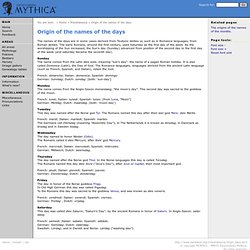
The early Romans, around the first century, used Saturday as the first day of the week. As the worshipping of the Sun increased, the Sun's day (Sunday) advanced from position of the second day to the first day of the week (and saturday became the seventh day). Sunday The name comes from the Latin dies solis, meaning "sun's day": the name of a pagan Roman holiday.
Origin of the names of the months. Romans - Mosaic. Information about Roman mosaics. History - Mosaics of Roman Britain Gallery. Romans_mosaic.pdf. Roman Food Facts: What Did the Romans Eat? The Romans ate a varied diet consisting of vegetables, meat and fish.
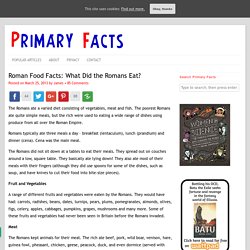
The poorest Romans ate quite simple meals, but the rich were used to eating a wide range of dishes using produce from all over the Roman Empire. Romans typically ate three meals a day – breakfast (ientaculum), lunch (prandium) and dinner (cena). Cena was the main meal. The Romans did not sit down at a tables to eat their meals. They spread out on couches around a low, square table.
Fruit and Vegetables. Roman food. How to draw a roman soldier. Roman Senator Royalty Free Stock Images - Image: 32067029. Romulus & Remus, The Story of. List of Roman gods and goddesses. Ancient Rome for Kids: Romulus and Remus. History >> Ancient Rome Romulus and Remus are the mythological twin brothers who founded the city of Rome.
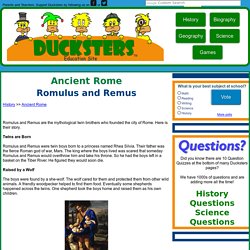
Here is their story. Twins are Born Romulus and Remus were twin boys born to a princess named Rhea Silvia. Monty Python - What have the romans ever done for us. Roman Inventions - Know the Romans. History of Ancient Rome for Kids: Roman Food, Jobs, Daily Life. History >> Ancient Rome A Typical Day A typical Roman day would start off with a light breakfast and then off to work.
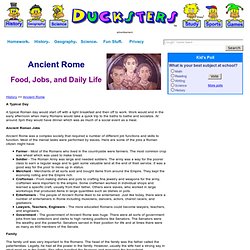
Work would end in the early afternoon when many Romans would take a quick trip to the baths to bathe and socialize. At around 3pm they would have dinner which was as much of a social event as a meal. History: Romans. 22-M-E-1. Ancient Rome Unit Study and Timeline by Cindy Downes - Oklahoma Homeschool. This unit is ©Copyright 2004-2010 by Cindy Downes.

All rights reserved. Permission is given to homeschooling parents and classroom teachers to use these units free of charge in their own homeschool or classroom only. These units may not be reprinted or distributed in any form, for any purpose (commercial or otherwise) without permission from Cindy Downes. Contact her at cindy@oklahomahomeschool.com. Index and Recommended Lesson Plan: Directions: This unit has been designed to be completed in nine weeks, covering two, 1 - 3 hour lessons per week. You can print off the free Ancient Rome Timeline Pieces and Timeline to use in your own homeschool. Unit Project Suggestion: Create a notebook for each unit. Back to Top Recommended Resources: Roman Numerals - How to Write Roman Numerals.
To make Roman numerals, we use seven letters from the alphabet.
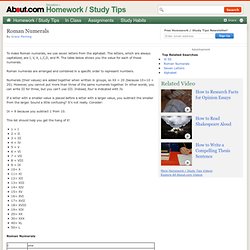
The letters, which are always capitalized, are I, V, X, L,C,D, and M. The table below shows you the value for each of these numerals. Roman numerals are arranged and combined in a specific order to represent numbers. Numerals (their values) are added together when written in groups, so XX = 20 (because 10+10 = 20). However, you cannot put more than three of the same numerals together. Roman Inventions - Know the Romans.
Rome-2-Naval-Invasion1. English Vocabulary Derived from Latin - Page 1. This section of EnhanceMyVocabulary.com is all about learning vocabulary derived from Latin Sixty percent of the English language comes from Latin.

In this section of Enhance My Vocabulary, you'll find many examples of Latin words and the English words derived from them. This is not an exhaustive list but will give you a good feel for the Latin roots of English. Challenge yourself to think of more English words that may have come from these Latin roots, and then check a dictionary to confirm the derivation. In her memoir, When All the World Was Young, Barbara Holland wrote that Latin was "the scalpel in my hand for dissecting English.
" Editor's note: This section would not be possible without the instruction of David L. TES - Log in or Register. Roman Architecture. By: Zinni N. The Colosseaum Romans are renowned for their impressive architecture. They introduced many new ideas and invented many new building styles such as the arch. The Romans also were the first to utilize previously untapped materials such as baked brick and cement. They built many famous buildings, some of which still stand today.
Map of italy. Roman_Empire_full_map. Map of The Roman Empire. This map shows the extent of the Roman Empire at three times in history: at the death of Caesar (44 B.C.E.), at the death of Augustus (14 C.E.), and at the death of Marcus Aurelius (180 C.E.).
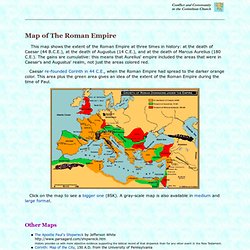
The gains are cumulative: this means that Aurelius' empire included the areas that were in Caesar's and Augustus' realm, not just the areas colored red. Caesar re-founded Corinth in 44 C.E., when the Roman Empire had spread to the darker orange color. This area plus the green area gives an idea of the extent of the Roman Empire during the time of Paul. Click on the map to see a bigger one (85K). A gray-scale map is also available in medium and large format. Paul's Letters to the Corinthians | Theme | Paul | Maps | Corinth | Church | Video | Order Study | | Bibliography | Glossary | Links | Timeline | Site Map | Notes and Credits. Rome. Hadrians_Wall_map. Hadrian's wall. Hadrian's Wall dig unearths Roman refugee camp. A major dig close to Hadrian's Wall has revealed traces of a suspected refugee camp which would have housed tribespeople fleeing south from a breakdown of society north of the imperial border in the third century AD.
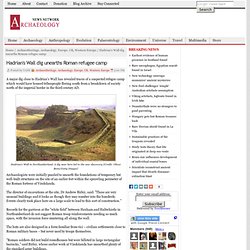
Archaeologists were initially puzzled to unearth the foundations of temporary but well-built structures on the site of an earlier fort within the sprawling perimeter of the Roman fortress of Vindolanda. The director of excavations at the site, Dr Andrew Birley, said: "These are very unusual buildings and it looks as though they may number into the hundreds. Events clearly took place here on a large scale to lead to this sort of construction.
" Bowness-on-Solway Travel Guide.